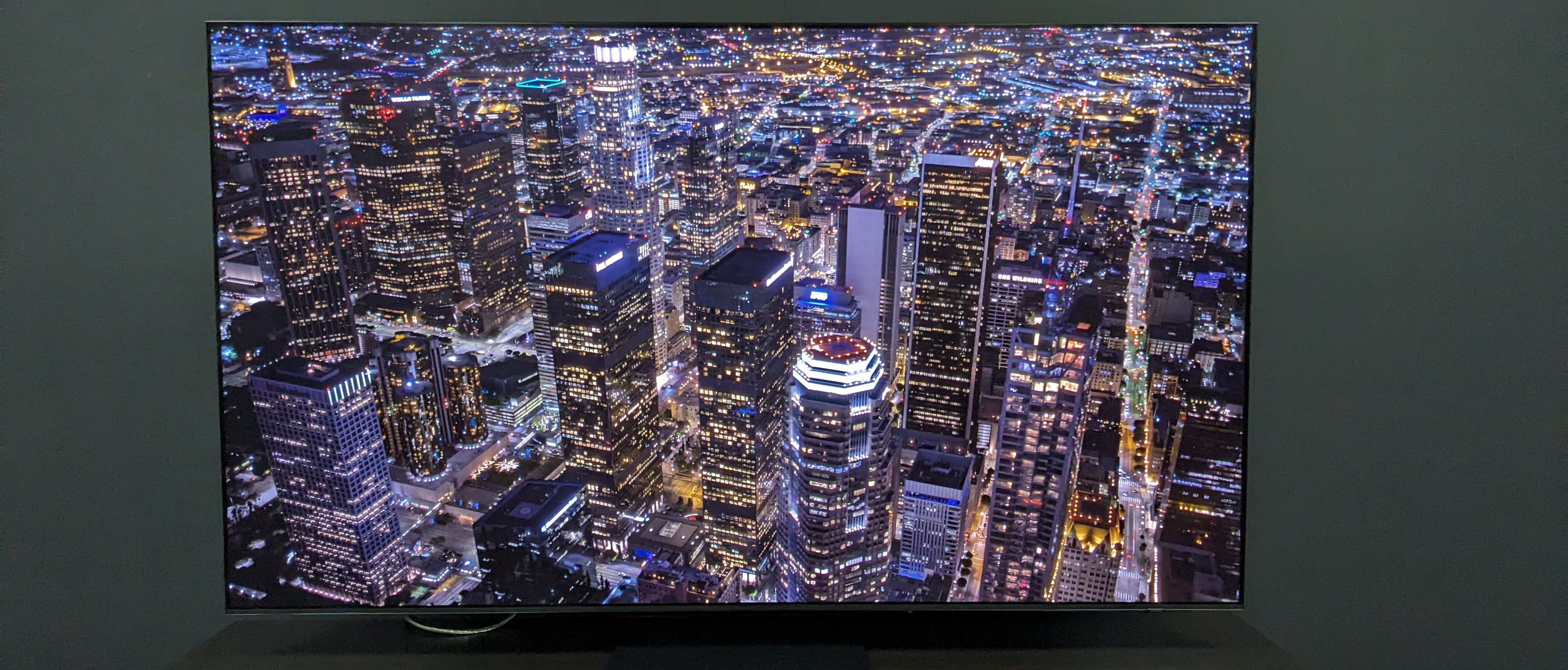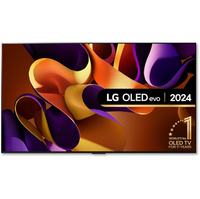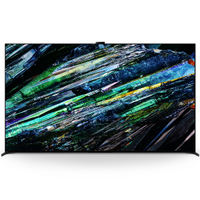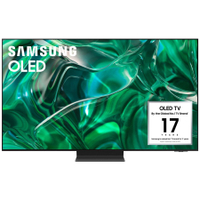TechRadar Verdict
The Samsung S95D is the very pinnacle of OLED TV. Stunning picture quality aided by AI and anti-reflection tech, stacks of features, outstanding gaming performance and a beautiful design combine to make a superb TV. This is what OLEDs should strive to be.
Pros
- +
Realistic picture detail
- +
Loaded with features for gaming
- +
Beautiful design
Cons
- -
Some black crush in Filmmaker Mode
- -
No Dolby Vision
- -
Pricey
Why you can trust TechRadar
Samsung S95D review: two minute review
The Samsung S95D is the definition of a premium OLED experience, with smart features and picture quality innovations that make it a standard bearer for OLED in 2024 - and cement its place as one of the best TVs of the year.
Priced as you would expect for a premium TV, the 65-inch S95D (the size we tested) sits at $3,399 / £3,399 / AU$4,995, which is roughly $100 more than its predecessor, the Samsung S95C. But then again, the S95D has new tech that wasn't present on the S95C.
The S95D is stacked with features to maximise picture, sound and gaming. Still, the NQ4 AI Gen2 Processor and OLED Glare Free tech are the stars of the show, with the latter effectively eliminating troublesome reflections with only minor picture quality sacrifices.
Picture quality is the absolute highlight of the S95D. Thanks to its QD-OLED panel and some clever AI picture enhancements, textures are ultra-realistic – never has an OLED TV looked more detailed. Colors are bold and dynamic, but have a natural look as well. Contrast is rich and shadows are as deep and detailed as you could hope for. There are some instances of black crush related to Samsung’s use of a matte screen, but this can be rectified and it doesn’t take away from the S95D easily being one of the best OLED TVs ever produced.
The S95D’s built-in sound is powerful, expansive and tightly controlled, and while it’s not going to beat the Panasonic MZ2000, Philips OLED908 or Sony A80L, it will suit most people just fine. But with an OLED picture like this, it’s worth getting one of the best soundbars to match.
The S95D has a ‘floating’ look thanks to a carefully designed and reassuringly sturdy stand, and its trim profile and near non-existent frame make it easily one of the best-looking TVs I’ve seen in years. Samsung’s One Connect Box external connections box, which keeps things tidy, is an added bonus.
Samsung’s TVs have counted amongst the best gaming TVs for years and with features such as 144Hz refresh rate, VRR with AMD FreeSync Premium Pro support and an excellent gaming hub, the S95D is no exception. Combine all that with a low 8.9ms input lag and you have a gamer’s dream TV.
Samsung’s Tizen smart TV interface may not be as refined or feature-packed as LG’s webOS 24, but it’s still a perfectly solid and serviceable platform that aims to keep things organized and simple for users.
It may be early days on the 2024 TV scene, but the Samsung S95D has already set a very high bar for other TVs and takes OLED to a whole new level.
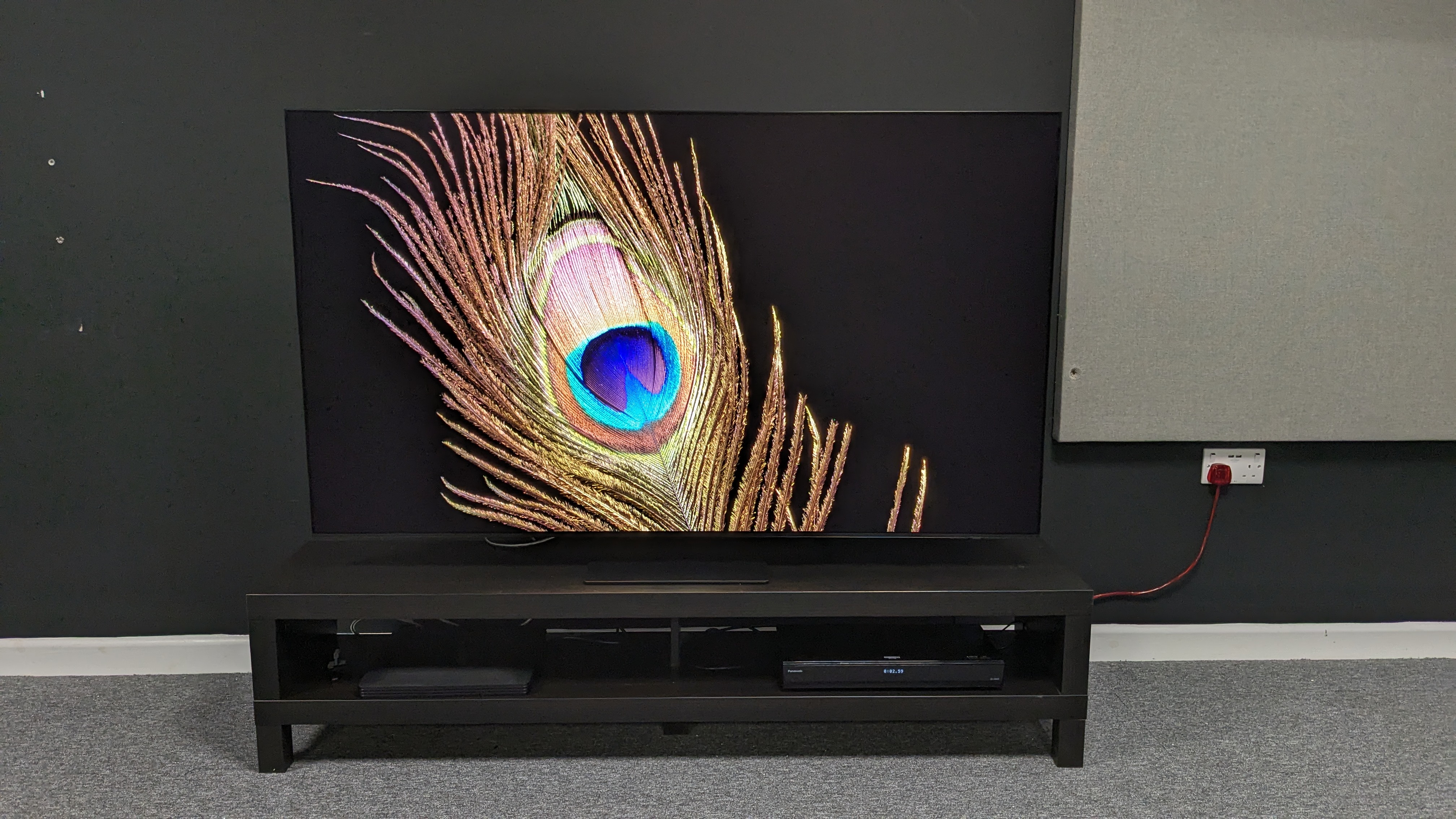
Samsung S95D review: Prices and release date
- Release date: March 2024
- 55-inch available from $2,599 / £2,499 / AU$3,995
- 77-inch available from $4,599 / £4,599 / AU$7,995
The Samsung S95D is the brand’s flagship OLED for 2024, following from 2023’s Samsung S95C. Released in March 2024, it is available in a 55-inch model, priced upon release at $2,599 / £2,499 / AU$3,995, a 65-inch model priced at $3,399 / £3,399 / AU$4,995 and a 77-inch model priced at $4,599 / £4,599 / AU$7,995. It’s roughly $100 more than the S95C was on release, but that was to be expected given its new anti-glare technology (more on that below).
However, we’re already seeing sales on the S95D just under a month after its release, with prices for the 65-inch model we tested down to $2,999 in the US and similar $300 price drops on other sizes. Although there are no offers at the time of writing in the UK and Australia, they are sure to follow.
Samsung S95D review: Specs
Screen type: | Quantum Dot OLED |
Refresh rate: | 120Hz |
HDR support: | HDR10, HDR10+, HLG |
Audio support: | Dolby Atmos, DTS |
Smart TV: | Tizen |
HDMI ports: | 4 HDMI 2.1 |
Built-in tuner: | ATSC 3.0 |
Samsung S95D review: Benchmark results
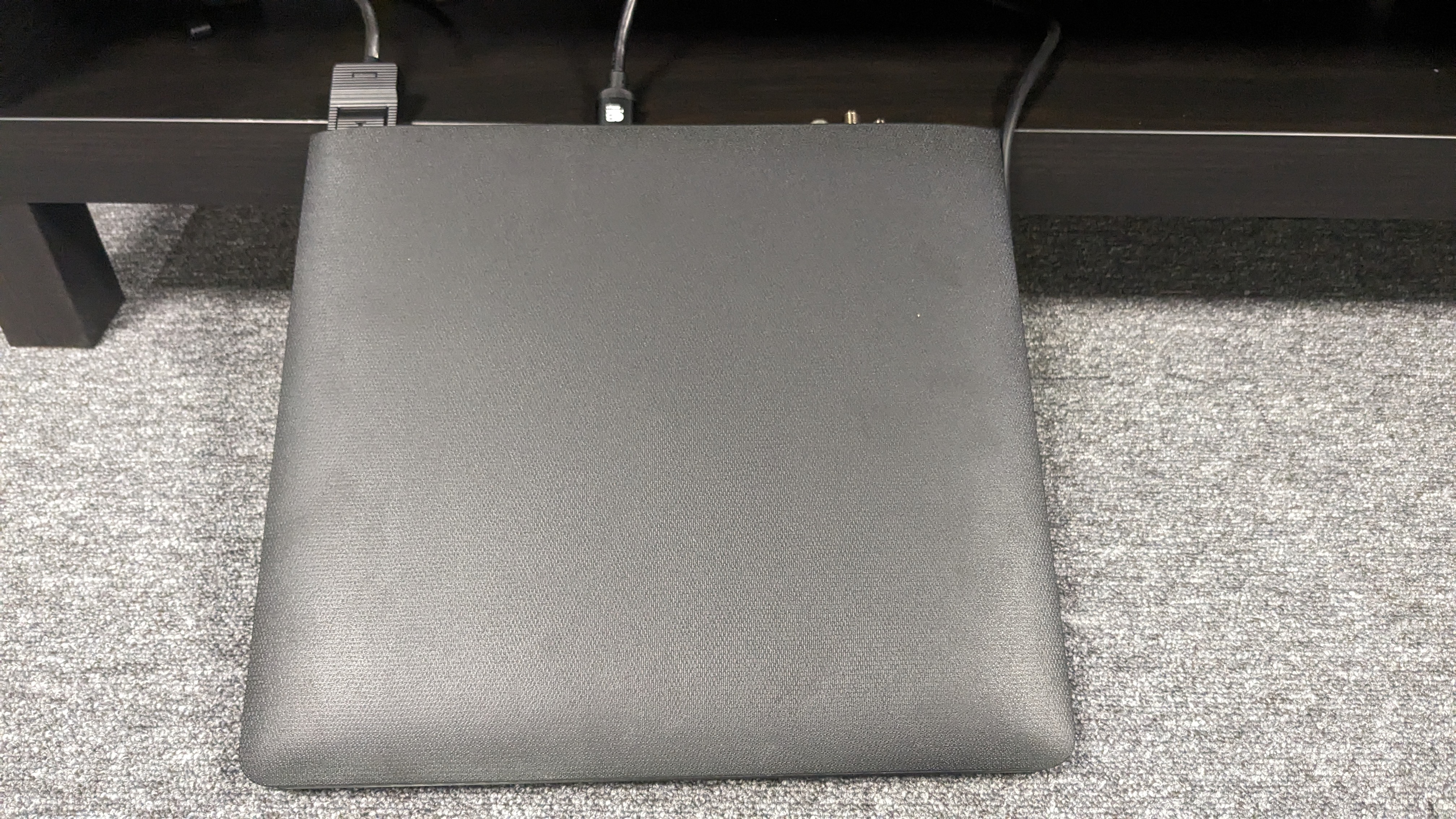
Samsung S95D review: Features
- OLED Glare Free screen
- NQ4 AI Gen2 Processor
- One Connect Box
The Samsung S95D carries many of the same features as its predecessor, the S95C, and that’s not a bad thing as the S95C was easily one of the best OLED TVs released in 2023.
Samsung again utilizes a QD-OLED panel to combine the rich contrast of OLED and the brightness of QLED in the S95D, but the headline feature is the new OLED Glare Free screen. This is a combination of anti-reflection tech and a new matte screen designed to reduce reflections caused by distracting light sources, and it is seriously effective.
The S95D comes with the new NQ4 AI Gen2 processor, with AI at the forefront of the TV’s processing via three areas: AI Picture, AI Sound and AI Optimization. Features such as Real Depth Enhancer and OLED HDR Pro are said by Samsung to bring new dimensions to picture quality and, frankly, it shows.
For HDR, the S95D supports the HDR10+, HDR10 and HLG formats but not Dolby Vision.
The S95D is stacked with gaming features, including four HDMI 2.1 ports that support up to 144Hz refresh rate, VRR with AMD FreeSync Premium Pro, ALLM and HGiG. It also has Samsung's Gamiing Hub that serves as a portal for all things gaming including cloud gaming services such as Xbox, Nvidia GeForce Now and Luna.
For audio, the S95D has a 4.2.2 speaker configuration with 70W of power. It uses Samsung’s Object Tracking Sound+ (OTS+) to connect the sound to the action on screen and supports Dolby Atmos, which is reproduced with good effect thanks to the TV’s real height speakers.
The S95D has an Infinity One design with a super-slim frame and profile. It also comes with Samsung’s One Connect Box, an external box for all connections including HDMI, optical digital audio and more, with the One Connect cable linking the box and the TV itself.
Samsung’s own Tizen smart TV platform provides access to expected apps such as Disney Plus, Netflix, and Prime Video. Tizen hasn’t seen many radical changes from last year. It’s worth noting for UK customers, however, that the S95D does not come with Freeview Play but rather Samsung TV Plus, so the layout of the TV guide will look different, though the same channels are supported.
- Features score: 5 / 5
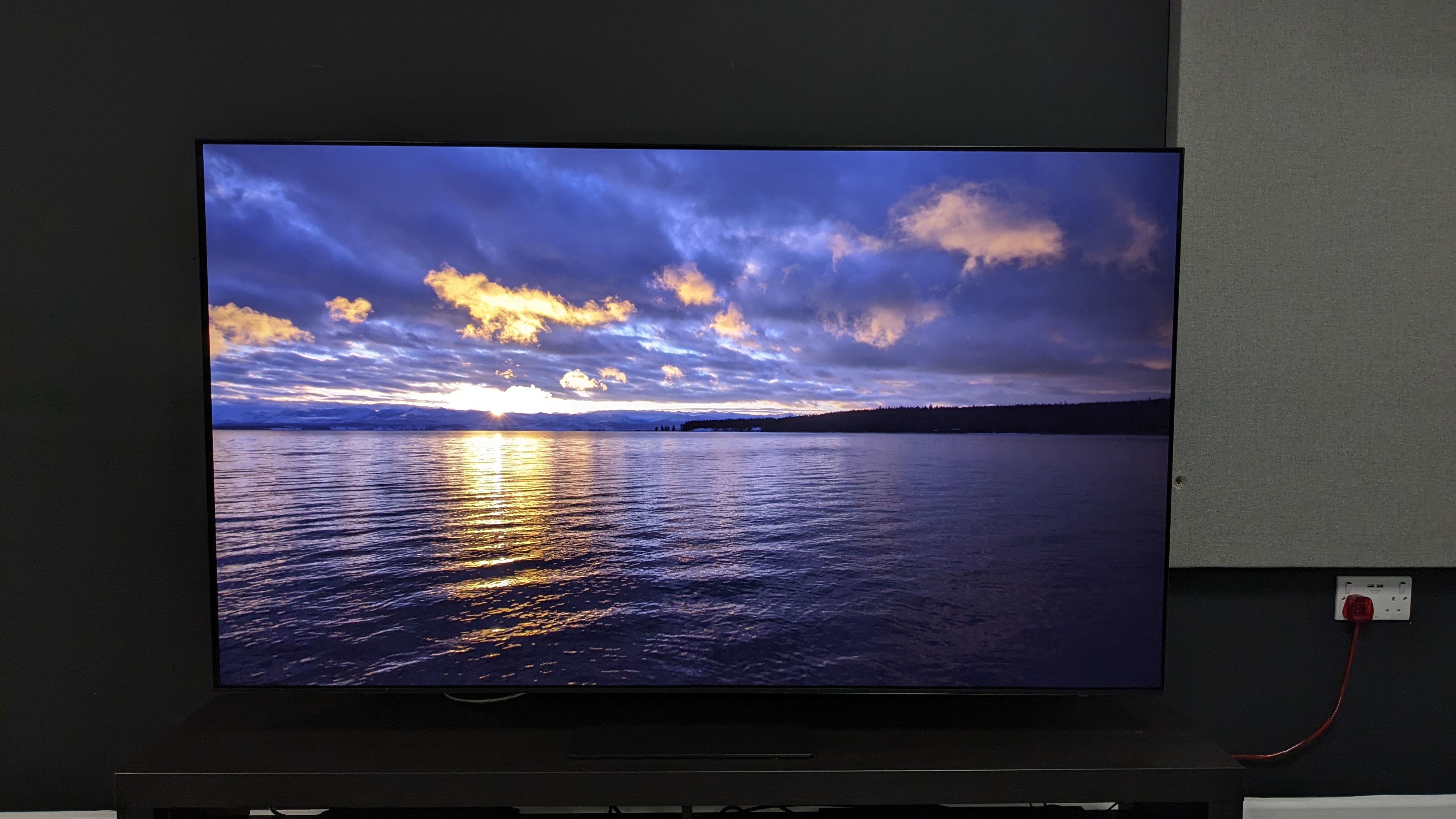
Samsung S95D review: Picture quality
- Exceptional detail
- Natural, rich colors
- Some black crush with Filmmaker Mode
The most intriguing feature of the S95D is its OLED Glare Free anti-reflection tech, which works to limit onscreen reflections.
When it comes to TV reflections, mirror-type ones, where an object or light source is clearly visible, are the most common. The S95D’s OLED Glare Free tech changes these to Haze-type refections, so even if a light source is reflected, it will have a fuzzy appearance that's far less distracting.
Tested in our lab, which has extremely harsh overhead lights, reflections on the S95D's screen were nearly impossible to see. A hazy reflection was still visible, but it took on no shape and wasn’t distracting even in dark scenes.
Before the S95D’s release, Samsung claimed it would be roughly 20% brighter than the S95C, which measured 1,400 nits on a 10% HDR white window when we tested it. When measuring the S95D, I clocked peak brightness at 1,868 nits and 1,688 nits on the same 10% HDR white window in Standard and Filmmaker picture preset modes, respectively. It also measured 327 and 318 nits full-screen brightness (100% HDR white window) in Standard and Filmmaker mode, respectively, making it the brightest OLED we’ve measured to date.
First viewing broadcast TV in both standard and high definition, the S95D did an effective job upscaling and smoothing out any rougher edges on the lower-resolution shows, even on the larger 65-inch screen I tested.
After cycling through the various picture presets, Filmmaker mode was the most accurate overall. Movie was a close second and provided more brightness and a little more contrast for darker scenes (more on that in a bit), but it didn’t quite have the same level of detail as Filmmaker.
Moving onto 4K movies with HDR, the incredible detailing of objects on the S95D was obvious. Textures were well-defined and true-to-life. Watching Top Gun: Maverick, I could see the stitching of Maverick’s jacket even from a distance. Faces and skin tones had almost photo-realistic accuracy as if they were actually in the room. This appears to be the work of the Real Depth Enhancer AI feature in action and it works wonders.
Colors on the S95D look bold and vivid, yet maintain a natural, refined quality. Watching Star Wars: The Last Jedi on Disney Plus, the throne room fight scene is dominated by the reds of the walls, the guards’ uniforms and a lightsaber, and the S95D displayed these with a dynamic punch that was also well-controlled. This was unsurprising as when I measured the S95D’s UHDA-P3 and BT.2020 color gamut coverage using Portrait Displays’ Calman calibration software, the results were a near-perfect 99.8% and 87.9%, respectively.
Motion is handled expertly by the S95D. In Filmmaker Mode, with all motion smoothing settings turned off by default, I saw no judder as jets quickly sped across the screen in Top Gun: Maverick or as the Batmobile weaved through traffic in the chase scene with the Penguin in The Batman.
Contrast on the S95D is also excellent, with the TV perfectly balancing light and dark in any scene with ease to add an extra layer of depth. Shadow details were also well maintained, with The Batman keeping its particularly gloomy tone. When I measured the S95D’s gamma and grayscale accuracy, it yielded a result of 3.7 (we typically look for below 3) which is a bit disappointing for a TV of this caliber. Still, it's hard to deny how good the S95D’s contrast was when I watched movies.
Black levels were suitably deep and near enough to the ‘true black’ OLED TVs are known for, although I did find that some scenes such as the crime scene investigation early in The Batman, showed black crush - a loss of detail in dark areas - in Filmmaker Mode. Details such as the bat on Batman’s suit and the pockets on Jim Gordon’s jacket disappeared altogether. But this could be due to the dimmer nature of Filmmaker Mode, since adjusting the Contrast Enhancer to Low or High in settings or switching to Movie mode rectified the issue.
The S95D’s AI picture processing, QD-OLED panel and OLED Glare Free screen tech combine to deliver one of the best OLED pictures I’ve seen to date. The S95D is already a standard bearer for 2024.
- Picture quality score: 5 / 5
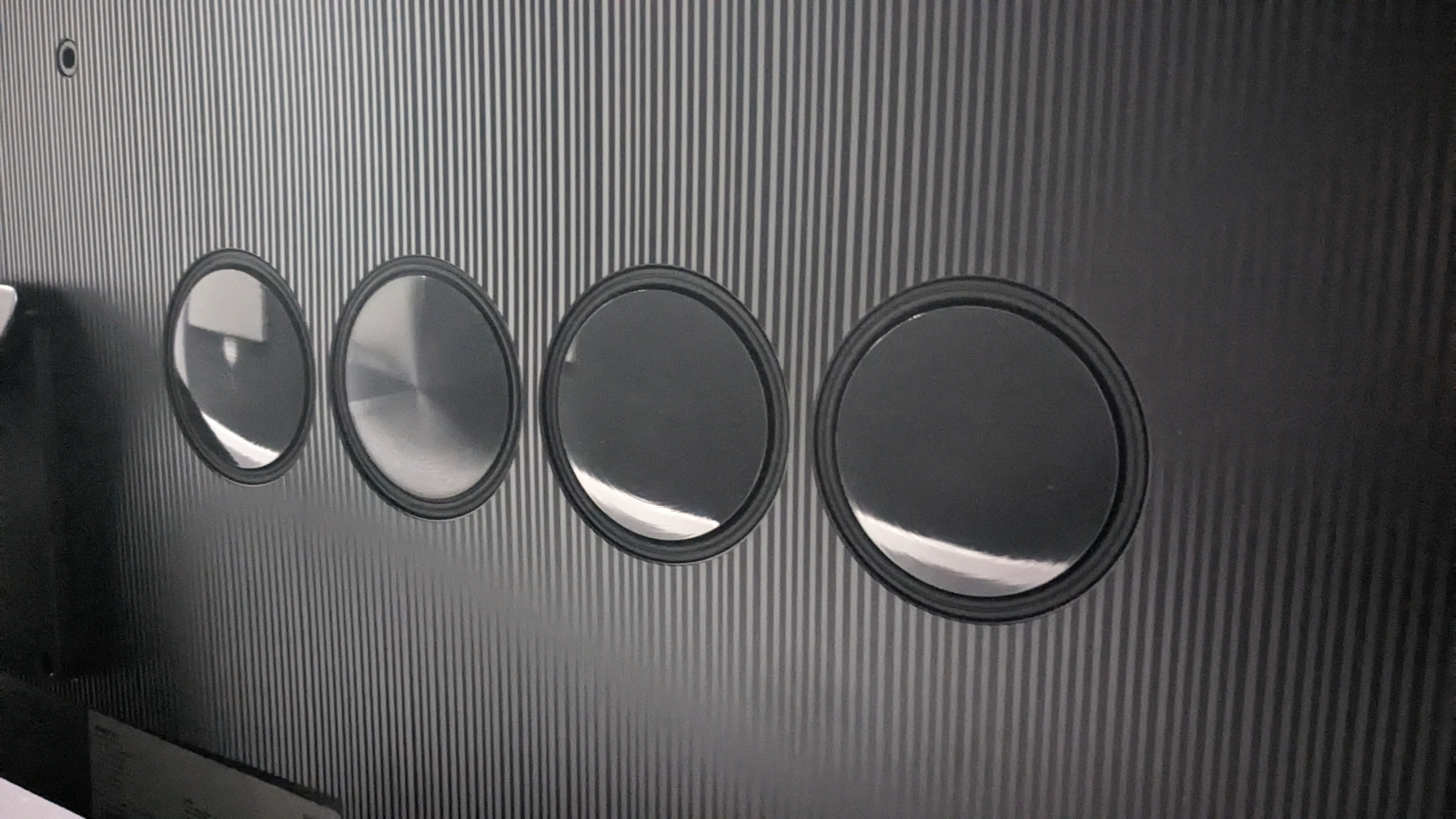
Samsung S95D review: Sound quality
- 4.2.2 channel speakers
- OTS+ is effective
- Deep, tightly controlled bass
The S95D has a 4.2.2 speaker configuration with 70W power and Dolby Atmos support. It also features AI sound settings such as Adaptive Sound Pro and Active Voice Amplifier that balance audio levels within movies and TV shows, prioritising dialogue without other elements.
Samsung’s Object Tracking Sound+ (OTS+) is excellent at connecting the sound with the action on the screen. During the Batmobile chase in The Batman, the sound of skidding cars and the Batmobile’s deep, roaring engine as it weaved through traffic all matched the picture flawlessly, and the same went for Top Gun: Maverick, as jets soared across the sky.
Bass is also a highlight of the S95D, with plenty of powerful rumble from the engines in both The Batman and Top Gun: Maverick. But, it’s not just power as the bass is tightly controlled and precise, giving the shake movie fans want without drowning out the rest of the mix. Dialogue is also clear regardless of what you’re watching even with the AI sound features turned off (the default setting).
Although the S95D’s built-in speakers are very good, its soundstage isn’t as immersive as some of the other best TVs for sound such as the Sony A80L, Panasonic MZ2000 or Philips OLED908. Also, I would have appreciated more sound modes than the two provided: Standard and Amplify.
While you’re unlikely to be disappointed by the S95D’s built-in sound, with a picture this good it’s worth adding one of the best Dolby Atmos soundbars to match, such as the Samsung HW-Q990D - which will utilize Samsung's Q Symphony feature when paired with Samsung TVs like the S95D.
- Sound quality score: 4 / 5
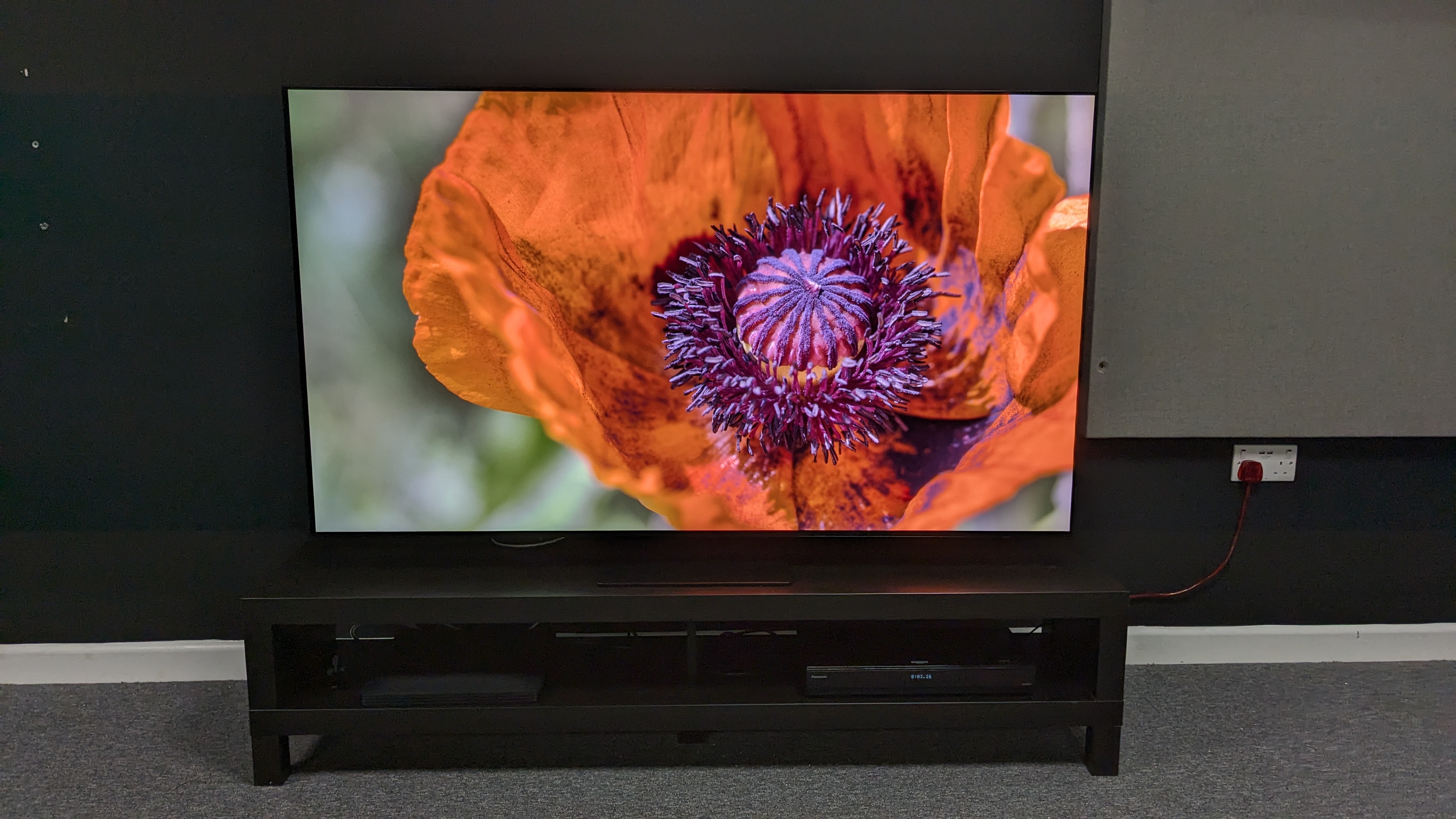
Samsung S95D review: Design
- One Connect Box
- Infinity slim frame
- Sleek ‘floating’ screen
The S95D is simply one of the best-looking TVs on the market. It feels every bit its premium price thanks to several design elements that give it a flagship feel.
Firstly, for those looking to wall-mount, the One Connect Box, which houses all connections such as HDMI, optical digital audio, power and more, is an external box that connects to the TV via one cable to keep things neat. And for those not wall-mounting, there’s a place to stash the Box on the back of the TV’s stand out of sight.
Speaking of the S95D’s stand, it’s a weighty metal design that feels suitably sturdy for a TV of this price range. Thanks to its shape and color, it almost disappears in dimmer conditions, giving the futuristic appearance of a floating screen.
The frame of the S95D is extremely thin. With a profile of just 11mm (0.4 inches), it gives the TV a sleek, modern look where all the focus is on the picture itself.
The S95D comes with two remotes: a more ‘traditional’ button-heavy one and a solar-powered smart remote. Both are functional and sturdy enough, but with other brands such as Sony and Philips upping their remote game on premium models, it would have been nice to see some change from Samsung. Buy that’s a small gripe on an otherwise perfectly designed TV.
- Design score: 5 / 5
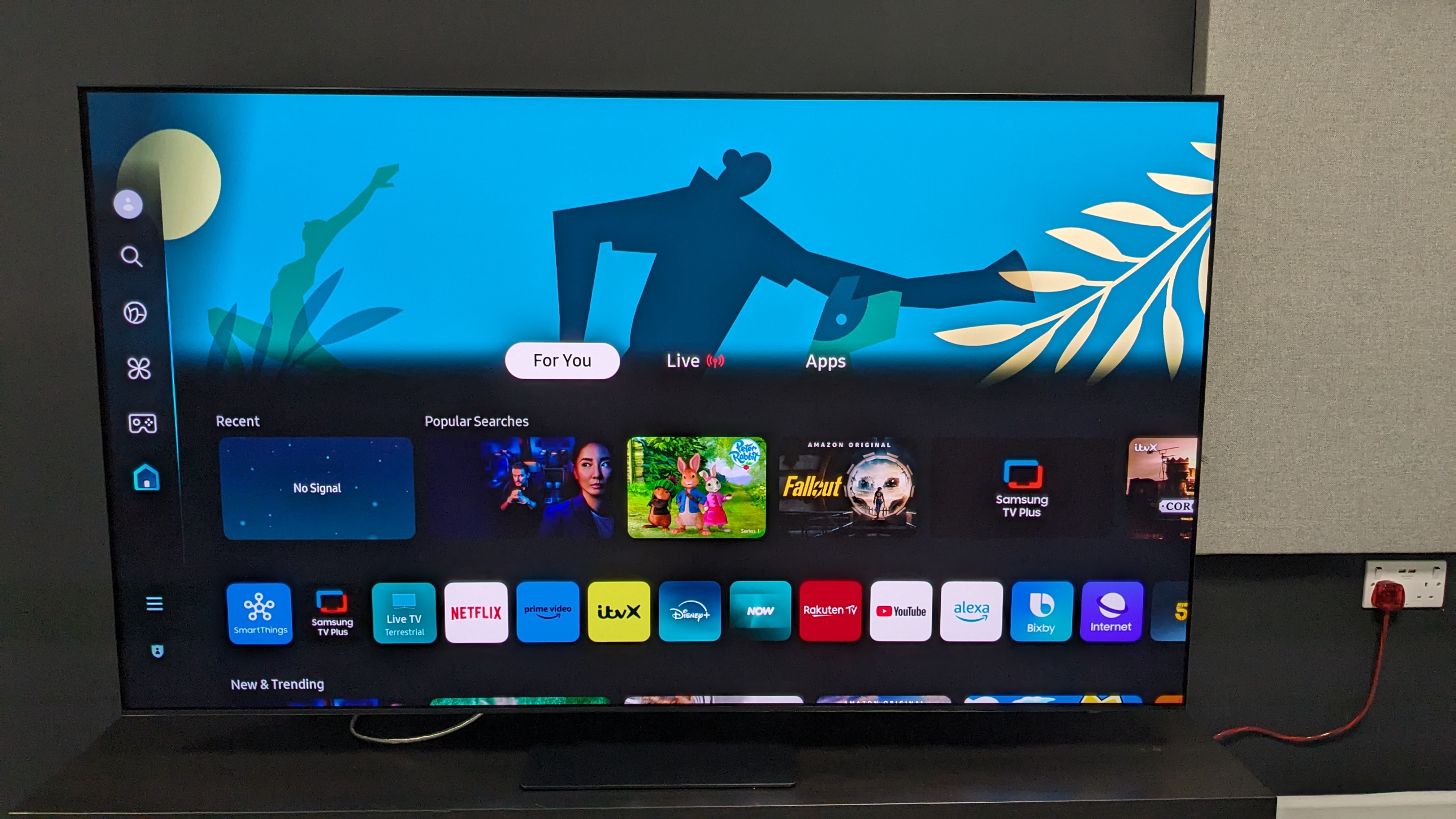
Samsung S95D review: Smart TV & menus
- Tizen smart TV platform
- Voice control options with Alexa and Bixby
- Categorized hubs for Gaming, Daily+ and more
The S95D uses Samsung’s own Tizen smart TV platform, which hasn't changed much over the years, although there have been a few updated and tweaked features.
Firstly, Tizen’s home menu continues to offer recommendations of trending TV shows and movies. While useful for some, these make the layout a bit cluttered compared to other smart TV platforms such as LG’s webOS 24 which takes a neater approach.
There are hubs for certain categories such as Gaming and the Daily+ hub, which incorporates lifestyle apps like Samsung Health, workspace, workout tracker and SmartThings. For those looking to use their TV as a central hub for all facets of life, Tizen provides.
In terms of settings to adjust picture, sound and accessibility, there is plenty on offer here compared to other platforms. Tizen continues to serve as a solid, if not a bit safe, smart TV platform with a great selection of apps and a decent amount of settings and menus to explore. It just feels like it could do with a bit of an update to catch up to other smart TV platforms.
- Smart TV & menus score: 4 / 5
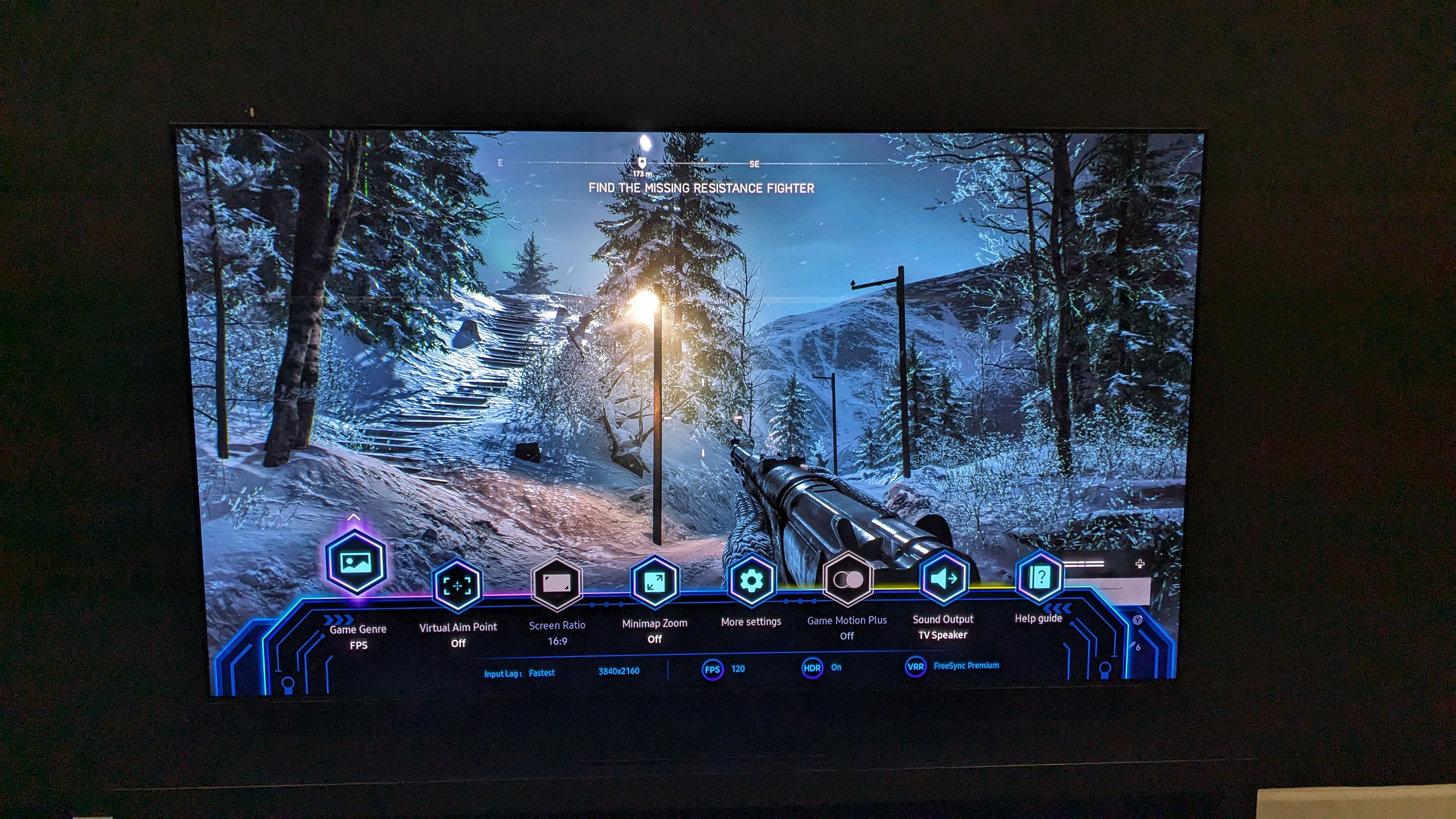
Samsung S95D review: Gaming
- Stacks of gaming features
- Useful Gaming Hub
- Ultra-low 8.9ms input lag
The S95D carries many of the gaming features we look for including 4K 120Hz (and up to 144Hz refresh rate for PC gaming), ALLM, VRR with AMD FreeSync Premium Pro support and HGiG. It also comes with four fully kitted-out HDMI 2.1 ports for those with multiple consoles.
The S95D handles graphically intense scenes with ease, as gaming feels fast, smooth and free-flowing with no interruptions to the action. When playing Battlefield V, quickly traversing environments whilst switching between targets was a breeze and always felt well-handled. That came as no surprise as when I measured the S95D’s input lag using a Leo Bodnar 4K HDMI input lag tester, it gave a result of 8.9ms, a stellar score (under 15ms is considered professional gaming levels).
The stunning picture quality that the S95D brings to movies and TV shows extends to video games. Object detailing is again outstanding, with every texture looking incredibly refined. In Battlefield V, every part of the weapon in the center of the screen was given a 3D-like effect, making it jump from the screen.
Samsung includes its Gaming Hub on the S95D, which collates everything to do with gaming, from incorporating your console into its interface (in our case an Xbox Series X) to offering an array of cloud gaming options from the likes of Xbox, Utomik, Nvidia GeForce Now and more. The Game Bar at the bottom of the screen is also useful for adjusting gaming settings on the fly for the relevant genre such as RPG and FPS, and has picture settings such as black level.
- Gaming score: 5 / 5
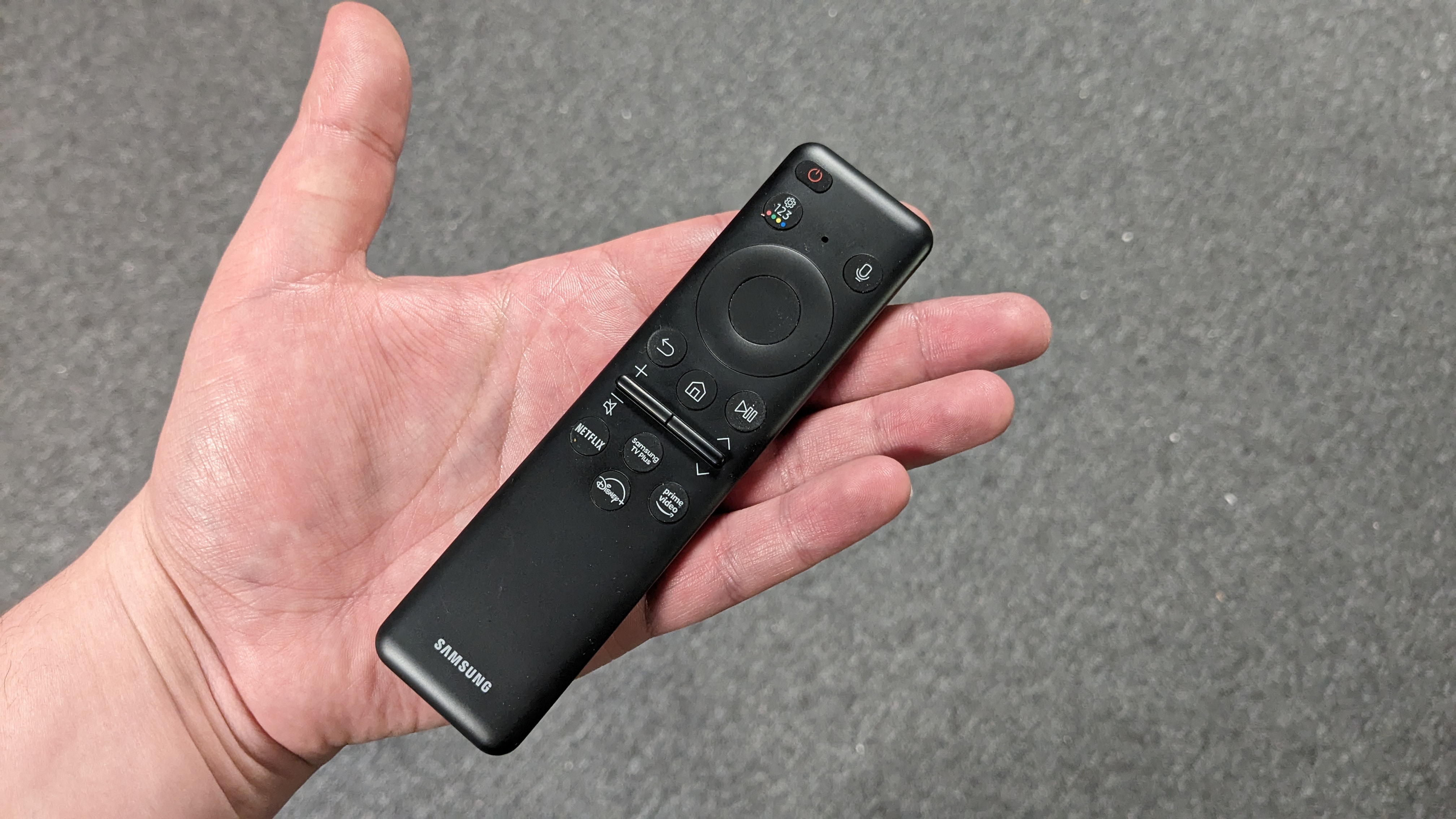
Samsung S95D review: Value
- Fairly priced for quality and features
- Similarly priced to rival OLEDs
- Cheaper QD-OLED alternative available
The S95D is without a doubt a premium OLED TV and as such, carries a premium price tag. The 65-inch version (the same size as our review model) is priced at $3,399 / £3,399 / AU$4,995. Arguably its biggest rival for 2024, the LG G4, is priced around $3,399 / £3,299 / AU$5,295, so there is almost nothing between them, and we’re likely to see prices drop on both models (the S95D has been discounted in the US already, although this may not be permanent).
Considering its picture quality and smart and gaming features, the S95D’s price seems justified, though there will be TVs this year that beat it in terms of value. And there is always the cheaper Samsung S90D (although whether you’ll get a QD-OLED or W-OLED panel is a mystery).
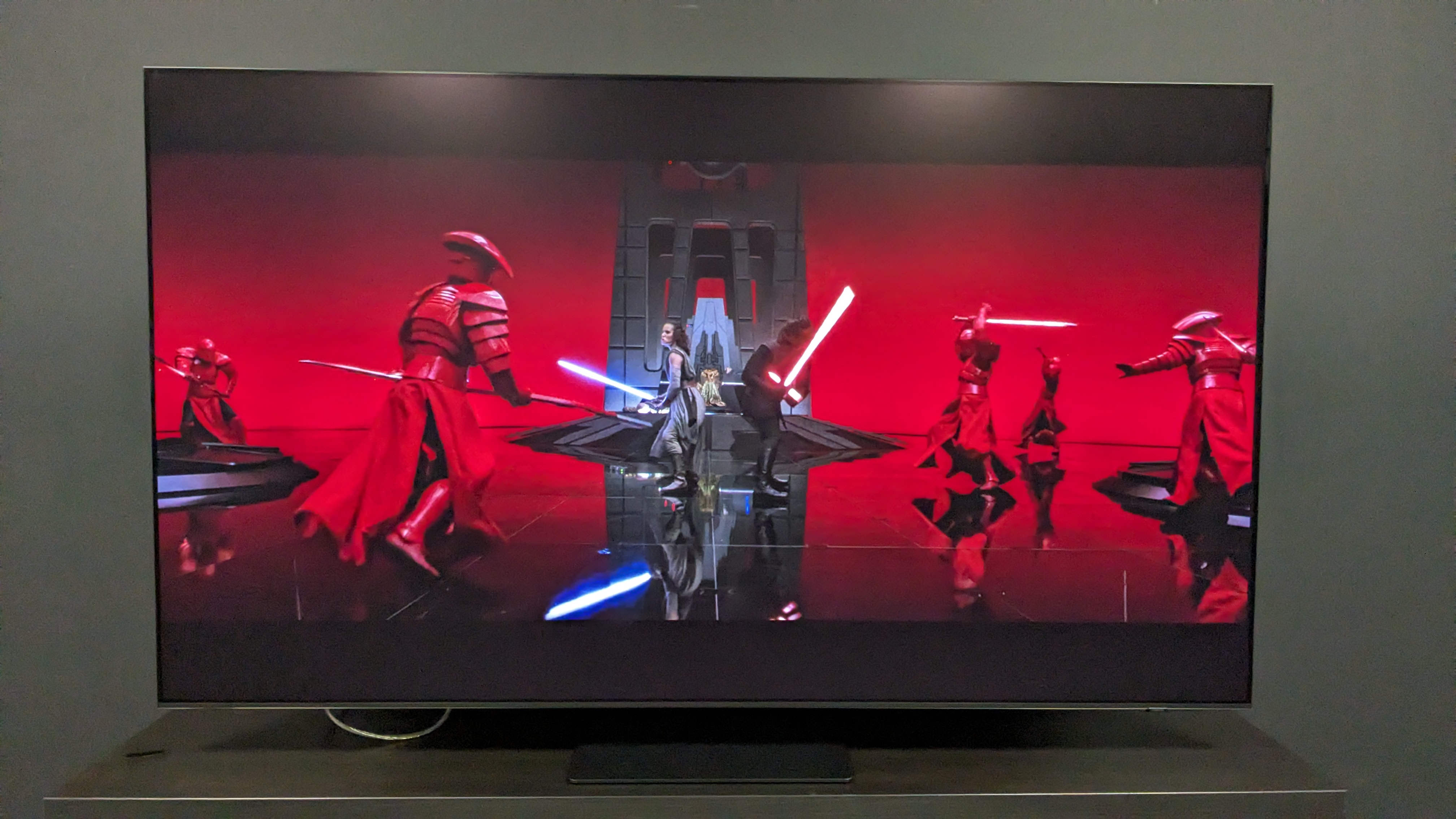
Samsung S95D review: Should I buy it?
Attributes | Notes | Rating |
|---|---|---|
Features | Tons of smart and gaming features, plus AI and anti-reflection tech | 5/5 |
Picture quality | Outstanding picture quality, aided by the OLED Glare Free tech | 5/5 |
Sound quality | Good quality speakers with decent bass and connection between sound and action on screen | 4/5 |
Design | A sleek, thin profile and a 'floating' design stand give this a stunning look | 5/5 |
Smart TV and menus | Lots of useful features and app access, but still not quite best in class | 4/5 |
Gaming | Carries nearly every gaming feature you could need and combines it with excellent performance | 5/5 |
Value | A premium TV that does justify its price, but is still no doubt expensive | 4/5 |
Buy it if...
You want sublime picture quality
By utilizing QD-OLED to its full extent and combining it with AI enhancements and OLED Glare Free, the S95D delivers one of the best pictures we've ever seen.
You want a top-tier gaming TV
The S95D carries nearly every gaming feature going and delivers it all with top-notch performance and picture quality.
You want a TV with a stellar design
Trim and sleek, the S95D has a 'floating' design that means all you see is a screen - plus its One Connect Box is useful for those looking to wall-mount.
Don't buy it if...
You don't want to mess with settings
While picture quality on the S95D is fantastic, there is some black crush in Filmmaker Mode - and you'll need to tweak some settings to get it right.
You want Dolby Vision HDR
Like all other Samsung TVs, the S95D does not support Dolby Vision HDR for movies or gaming.
You are on a budget
Despite it justifying its price tag, the S95D is still undoubtedly a pricey TV and will stretch most people's budgets.
Samsung S95D review: Also consider
| Header Cell - Column 0 | Samsung S95D | LG G4 | Sony A95L | Samsung S95C |
|---|---|---|---|---|
Price (65-inch) | $3,399 / £3,399 / AU$4,995 | $3,299 / £3,299 / AU$5,295 | $3,299 / £3,199 / AU$5,995 | $2,199 / £1,899 / AU$4,399 |
Screen type | QD-OLED | OLED (MLA) | QD-OLED | QD-OLED |
Refresh rate | 144Hz | 144Hz | 120Hz | 144Hz |
HDR support | HDR10+, HDR10, HLG | Dolby Vision, HDR10, HLG | Dolby Vision, HDR10, HLG | HDR10+, HDR10, HLG |
Smart TV | Tizen | webOS 24 | Google TV | Tizen |
HDMI | 4 HDMI 2.1 | 4 HDMI 2.1 | 2 HDMI 2.1 | 4 HDMI 2.1 |
LG G4 OLED TV
The LG G4 is set to be the S95D's most direct competition, continuing to use MLA to provide extra brightness to LG's excellent OLED picture. We haven't fully tested the G4 just yet, but from what we've seen in-person, it could be another top OLED TV contender - plus we loved its predecessor, the LG G3.
Sony A95L QD-OLED TV (2023)
The Sony A95L will continue as Sony's flagship OLED in 2024 after release in 2023. We haven't had a chance to fully test the A95L, but in our hands-on test, we were impressed by its brightness, black levels and gaming performance.
Samsung S95C QD-OLED TV (2023)
The predecessor to the S95D, the S95C carries a lot of the same great picture quality and features of the S95D, now at a fraction of the cost. However, it doesn't come with the OLED Glare Free tech or AI enhancements found in the S95D.
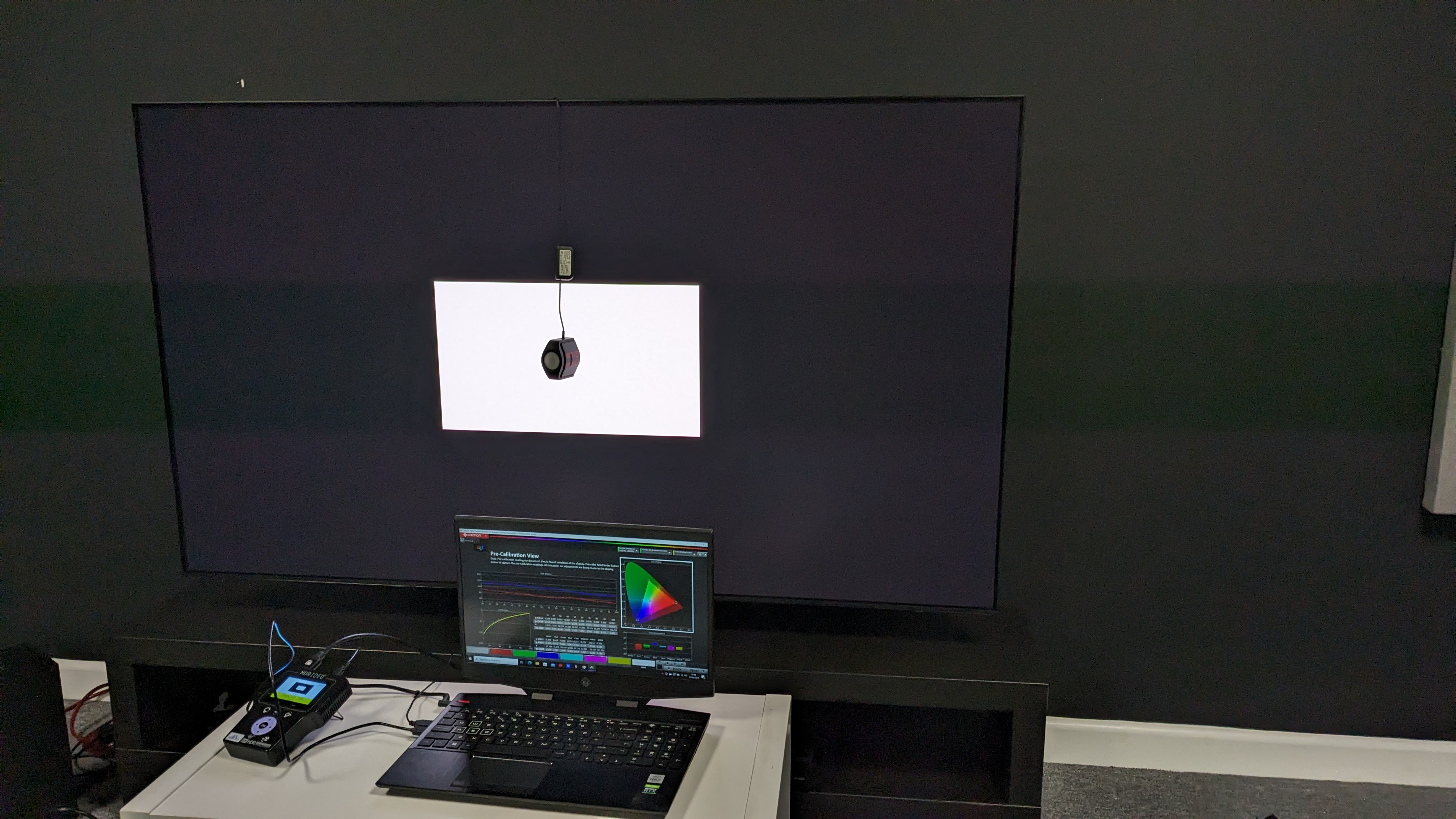
How I tested the Samsung S95D
- Tested using a variety of SDR and HDR sources
- Tested in various lighting conditions
- Measurements taken using Portrait Displays' Calman Calibration software
To test the Samsung S95D, I started with subjective testing, analyzing picture quality, sound quality, gaming performance and more, before taking specific measurements using specialized equipment.
Using broadcast TV, HD streaming, and HDR sources such as 4K Blu-ray, I tested the S95D's preset picture modes to determine the most accurate one, which was Filmmaker Mode. I then used this mode to critically analyze the S95D's picture quality, looking at black levels, contrast, color, motion and more. I also used these same sources to evaluate the TV's built-in audio.
To test gaming performance, I used an Xbox Series X to test refresh rate, gaming features and picture quality.
For objective tests, I used a colorimeter, test pattern generator and Portrait Displays' Calman calibration software to measure SDR and HDR brightness, color accuracy, and HDR color gamut coverage.
Finally, I used a Leo Bodnar 4K HDMI input lag tester to test the S95D's input lag in milliseconds whilst the S95D was in its Game Mode.
For a more detailed breakdown, check out our guide on how we test TVs at TechRadar.
- First reviewed: April 2024
- Read TechRadar's review guarantee

James is the TV Hardware Staff Writer at TechRadar. Before joining the team, he worked at a major UK based AV retailer selling TV and audio equipment, where he was either telling customers the difference between OLED and QLED or being wowed by watching a PS5 run on the LG 65G2. When not writing about the latest TV tech, James can be found gaming, reading, watching rugby or coming up with another idea for a novel.
